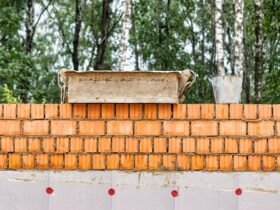Retaining walls are vital structures in landscaping and civil engineering, designed to manage soil and provide stability on sloped terrains. Ensuring their structural integrity is paramount for safety and longevity. This comprehensive guide explores critical safety considerations for retaining walls, encompassing load-bearing requirements, drainage systems, geotechnical engineering principles, safety regulations, and detailed guidelines for conducting thorough safety inspections.
Understanding Load-Bearing Requirements
Understanding the load-bearing requirements is fundamental to designing and constructing robust retaining walls. Several factors influence the load-bearing capacity of a retaining wall:
Soil Characteristics
- Soil Type: Different soils exert varying lateral pressures on retaining walls. Cohesive soils like clay can exert significant pressure, whereas granular soils are generally easier to manage.
- Soil Bearing Capacity: The ability of the soil to support the weight of the retaining wall and any additional loads must be carefully assessed.
- Water Content: Saturated soils increase lateral pressure, impacting the stability of the wall.
Height and Slope Considerations
- Height: Taller retaining walls require stronger materials and deeper foundations to withstand increased pressure and prevent overturning or sliding.
- Slope Angle: Steeper slopes exert more pressure on the wall, necessitating more robust design and construction.
Surcharge Loads
- External Loads: Consider additional loads from nearby structures, traffic, landscaping features, or buildings that could impact the stability of the wall.
- Impact: Surcharge loads can significantly affect the design requirements and structural integrity of the retaining wall.
Proper Drainage Systems to Prevent Wall Failure
Effective drainage systems are critical in preventing water buildup behind the retaining wall, which can lead to hydrostatic pressure and potential failure. Key components of proper drainage include:
Weep Holes
- Function: Weep holes allow water to drain freely from behind the wall, relieving hydrostatic pressure.
- Spacing and Placement: Properly spaced weep holes along the length of the wall ensure uniform drainage and prevent localized pressure buildup.
- Maintenance: Regularly inspect and clear weep holes of debris to maintain their effectiveness.
Drainage Pipes
- Perforated Pipes: Installed at the base of the wall behind the drainage aggregate to collect and redirect groundwater away from the wall.
- French Drains: Gravel-filled trenches lined with perforated pipes to intercept and channel subsurface water away from the wall’s base.
- Importance: Proper drainage reduces the risk of soil saturation, frost heave, and hydraulic pressure that can compromise the wall’s stability.
Backfill Material
- Characteristics: Use well-draining backfill material to facilitate water movement away from the wall.
- Compaction: Properly compact backfill to ensure uniform support and prevent settlement that could undermine the wall’s foundation.
The Importance of Geotechnical Engineering in Retaining Wall Design
Geotechnical engineering principles are essential for the safe and effective design of retaining walls. Key considerations include:
Soil Analysis and Testing
- Site Investigation: Conduct thorough soil tests to determine properties such as bearing capacity, shear strength, and permeability.
- Laboratory Testing: Analyze soil samples to assess their behavior under load, ensuring accurate design parameters.
- Groundwater Conditions: Evaluate groundwater levels and flow patterns to mitigate potential hydrostatic pressure on the wall.
Structural Design
- Foundation Design: Design foundations based on soil characteristics to ensure adequate bearing capacity and stability.
- Reinforcement: Incorporate geosynthetic reinforcements like geogrids or soil nails to enhance soil stability and prevent wall movement.
- Load Distribution: Calculate and distribute loads evenly to minimize stress concentrations that could lead to failure.
Stability Analysis
- Factor of Safety: Calculate the factor of safety against overturning, sliding, and bearing capacity failure to ensure structural stability.
- Computer Modeling: Utilize advanced software to simulate various scenarios and optimize wall design based on site-specific conditions and project requirements.
Safety Codes and Regulations for Retaining Walls
Adherence to safety codes and regulations is crucial to ensure the structural integrity and safety of retaining walls. Key regulatory considerations include:
Building Codes and Zoning Ordinances
- Local Requirements: Comply with building codes specific to retaining walls, including minimum height, setback from property lines, and maximum surcharge loads.
- Design Criteria: Ensure that the design meets or exceeds minimum safety standards set by local authorities.
International Standards
- ASTM Standards: Guidelines for materials, testing, and construction practices specific to retaining walls.
- Eurocode: European standards for structural design, safety factors, and durability considerations.
Permitting and Inspection
- Permit Approval: Obtain necessary permits before construction begins, ensuring compliance with legal requirements and safety standards.
- Inspection Requirements: Schedule inspections at key construction milestones to verify compliance with approved plans and ensure quality assurance.
How to Conduct a Safety Inspection of Your Retaining Wall
Regular safety inspections are essential to identify potential issues early and maintain the structural integrity of retaining walls. Follow these guidelines for conducting thorough safety inspections:
Visual Examination
- Surface Inspection: Check for cracks, bulges, or signs of movement along the surface of the retaining wall.
- Weep Holes and Drainage: Inspect weep holes for blockages and ensure proper drainage functionality.
- Vegetation and Surcharge: Assess the impact of nearby vegetation or surcharge loads on the wall’s stability.
Structural Integrity
- Alignment and Plumb: Use a level to check the alignment and plumb of the retaining wall, ensuring it hasn’t shifted or settled.
- Foundation Stability: Examine the base of the wall for signs of settlement or erosion that could compromise the foundation.
Documentation and Record-Keeping
- Maintenance Logs: Maintain detailed records of inspections, maintenance activities, and any repairs performed on the retaining wall.
- Professional Inspection: Periodically engage a qualified engineer to conduct comprehensive inspections and assessments of the wall’s structural condition.
FAQs about Safety Considerations for Retaining Walls
Common signs include visible cracks, bulging, leaning, or tilting of the wall. Additionally, signs of excessive settlement, drainage issues, or vegetation growth near the wall can indicate potential stability problems.
Ensure weep holes are clear and functioning correctly to allow water drainage. Consider installing or maintaining drainage pipes or French drains to divert water away from the base of the wall. Use well-draining backfill material to facilitate proper drainage.
Yes, building codes and zoning ordinances govern the design, construction, and placement of retaining walls. These regulations include requirements for wall height, setback distances from property lines, and maximum allowable surcharge loads.
Regular inspections are recommended annually, particularly after extreme weather events like heavy rainfall, freeze-thaw cycles, or seismic activity. Additionally, inspect the wall if you notice any signs of damage or instability.
Geotechnical engineers assess soil conditions, design appropriate foundations, and recommend reinforcement techniques to enhance the stability and safety of retaining walls. Their expertise ensures that walls can withstand external forces and environmental conditions effectively.
Permit requirements vary by location and depend on factors such as wall height, proximity to property lines, and local building codes. Check with your local building department or municipality to determine specific permit requirements before starting construction.
Conclusion
By prioritizing these safety considerations and adhering to best practices in design, construction, and maintenance, property owners and engineers can ensure that retaining walls remain safe, functional, and reliable assets for protecting landscapes and structures. Regular inspections and proactive maintenance are key to mitigating risks and extending the lifespan of retaining walls effectively.










